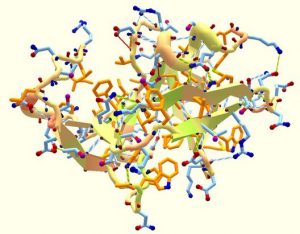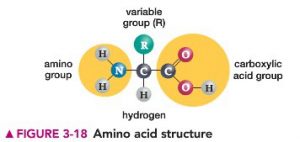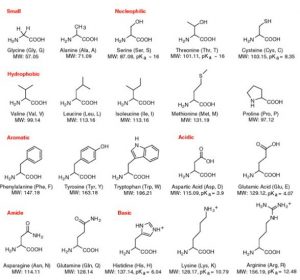Protein Assembly
Proteins
Proteins are the most diverse class of biological molecule. They are composed of long chains of smaller subunits called ‘amino acids’ and proteins can be ‘folded’ into many different structural configurations, resulting in a vast array of possible functions provided to the cell.
Let’s take a closer look now…

Protein Assembly
Proteins are composed of a series of smaller subunits called ‘amino acids’ which are joined together into a long chain. If we examine the chemical structure of an amino acid, we can see that it is based upon a central carbon atom bonded to (3) discrete groups along with a hydrogen atom:

On the left side of the amino acid above, we find an ‘amino group’ which is based upon the nitrogen atom. It is the presence of this group which provides the ‘amino’ in ‘amino acid’.

On the right side of the amino acid, we find a ‘carboxylic acid group’. It is the presence of this group which makes an ‘amino acid’ an ‘acid’.


Protein Assembly- video
Proteins are composed of a series of smaller subunits called ‘amino acids’ which are joined together into a long chain. The video below explores how proteins are assembled from amino acids.
Summary
Proteins are composed of a series of smaller subunits called ‘amino acids’ which are joined together into a long chain. If we examine the chemical structure of an amino acid, we can see that it is based upon a central carbon atom bonded to (3) discrete groups along with a hydrogen atom:

- On the left side of the amino acid above, we find an ‘amino group’ which is based upon the nitrogen atom.
- On the right side of the amino acid, we find a ‘carboxylic acid group’.
- At the top of the amino acid, we find the presence of a ‘variable group’. There are (20) different groups which can be found in this position on the amino acid generating a total of (20) different amino acids in nature. Some of these groups can be hydrophobic, some hydrophilic while others can form strong chemical bonds with one another.